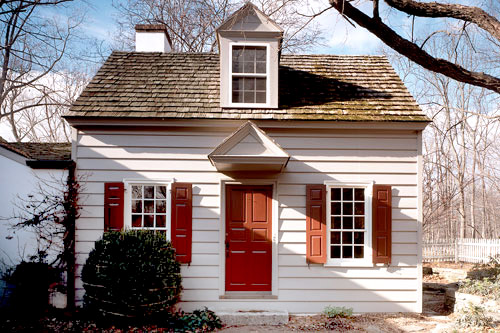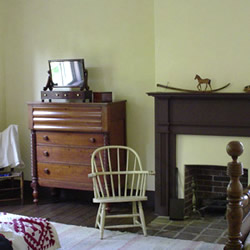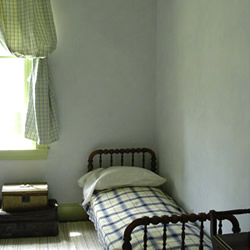
Old World Paints
Milk paint and other old-school coatings are making a comeback.
by Christina Camara
but Barbara Carbiener is more sensitive to color than your average diner.
Carbiener, owner of Olde Century Colors, based in New Carlisle, Ind., just couldn’t stomach the paint color in her neighborhood Denny’s, so she and her friends found another place to eat breakfast after church.
Color can calm, color can soothe, color can rev you up, and as Carbiener discovered, it can make you feel nauseated.
Because homeowners are so interested in color as a mood setter and as a decorating “glue” that pulls an entire room together, contractors have a huge opportunity to educate their customers about the intensely pigmented colors of old-fashioned paints.
Olde Century Colors offers early American colors that are so heavily pigmented that they can’t be reproduced by mixing tints and bases at the paint store. Dry pigments are ground down to a powder and mixed into a base at the factory. The colors are mixed in small batches of about 200 gallons at a time, each identified by a dye lot.
The result is a depth of color that makes inexpensive paints look like colored water, Carbiener says. “It’s paint, but there’s no body to it, there’s no oomph to it, there’s no great color.” Cranberry is the company’s perennial best-seller.
Edwin Stulb III, a fifth-generation paint-maker with Old Village Paint Colours of Perkiomenville, Penn., says, “The colors are made the same way they were when I was 15 years old and in the paint business with my dad and uncle.” In the late 1930s and early 1940s, alkyd vehicles and latex resins had not been developed, and linseed oil and lead were used for exterior paints.
“The restoration of the Wylie House, circa 1835, utilized coatings made by Old Fashioned Milk Paint Co., of Groton, Mass.” |

The walls in the boys’ bedroom were done with 12 parts Snow White mixed with 1 part Marigold. |

The sick room was painted with three coats of milk paint: 1 part Slate Blue mixed with 13 parts Snow White. It was mixed thin (added more water) and so it took three coats. |

The dining room walls were painted in Pumpkin color milk paint above the chair rail. The ceiling received 9 parts Snow White to 1 part Pumpkin, with Extra-Bond added. Two coats were applied. Below the chair rail, two coats of Slate Blue was used at full strength. |

The master bedroom walls were painted with a mixture of 1/2 c. Marigold Yellow, 1/2 c. Tavern Green and 1/8 c. Snow White with enough water to make 16 ounces. To this was added 8 ounces of Extra-Bond. The second coat included the same proportions of color, but with no Extra-Bond. |

The guest room was painted with 1 part Driftwood and 9 parts Snow White, plus Extra-Bond.
www.iub.edu/~libwylie |
| |
| |
Old Village also pre-mixes their paint in small batches, producing rich, authentic colors used in early America: New England Red, Cabinet Makers Blue, Pearwood, Windsor Green and Valley Forge Mustard, to name a few. Old Village, in act, offers a line of buttermilk paint colors that match furniture in the Abby Aldrich Rockefeller Folk Art collection owned by the Colonial Williamsburg Foundation.
Intense color is usually what attracts homeowners and paint contractors to historic paints, but once they use it, they’re hooked, Stulb says. While the paints are more expensive, at $45 or $50 a gallon, the paint is easy to use and goes much farther, covering 400 square feet in one coat in most cases. The paint hides well and is super-durable. (One Bucks County, Penn., customer told Stulb that she painted her house 26 years ago — and it still looks new.) Stulb says his company’s interior and exterior acrylic latex, with a satin finish, is the best paint made in America, “and we’re not the least bit worried about making that statement.”
Old Village, along with Olde Century, continues to make even smaller batches of oil-based paints for those die-hards who prefer it. “We can only do quarts and pints, but we sell kazillions of them,” Stulb says. “It goes on like butter. It’s unbelievable.”
Milk paint, with its uneven finish and velvety quality, has long been used on antique reproductions to produce an old-world look. Anne Thibeau, president of the Old Fashioned Milk Paint Co. of Groton, Mass., says her father, now 80, developed their paint so he would have a historically accurate finish for the Windsor chairs, Shaker reproductions and other country furniture pieces he made himself. Dozens of trips to the Boston Public Library and a few hundred experiments later, he found a formula that worked, and he started his company in 1974.
Casein, the protein found in milk, is a strong binder. In Colonial America, itinerant painters carried their own pigments, mixing them with a farmer’s milk and lime. Today, the company combines earth pigments and other natural fillers and sells the paint powder in bags to be mixed with water.
“It’s not as simple as opening up a can of paint, but you get results with milk paint you just can’t get with a modern paint,” Thibeau says. “There’s no real substitute for milk paint.”
Milk paint fell out of favor with the advent of modern latex paint, Thibeau says, but health and environmental concerns are driving strong demand for milk paint once again.
It gives off zero VOCs and has a faint milky smell when wet but no odor when it’s dry. It’s more labor-intensive to apply, but it cleans up with soap and water. “Contractors are calling us and saying it’s specified by the architects,” she says. “Sometimes it’s for the look, but a lot of times it’s for the environmental benefits.”
To meet this demand, the Old Fashioned Milk Paint Co. is developing a new line of paint for walls, which includes a polymer emulsion to aid in adhesion to nonporous surfaces. The additive, Extra-Bond, is not natural, but it contains zero VOCs. The new formulation will allow painters to keep a wet edge longer, and the finished look will be somewhat more consistent and less mottled than traditional milk paint, which will always be the best choice for porous surfaces, Thibeau says.
The new paint will be called SafePaint. “We’ve hit the nail on the head,” she says. “We’re very, very excited about this.”
Historic paints can help contractors market themselves in a new way: ease of use, durability, one-coat coverage, and the intensely rich colors available are powerful selling points.
“If they offer their customers a wider, broader range of colors, in a premix, they’re going to open doors for themselves,” Carbiener says. “They should try to accommodate their customers. They may not know what’s out there.”

|

